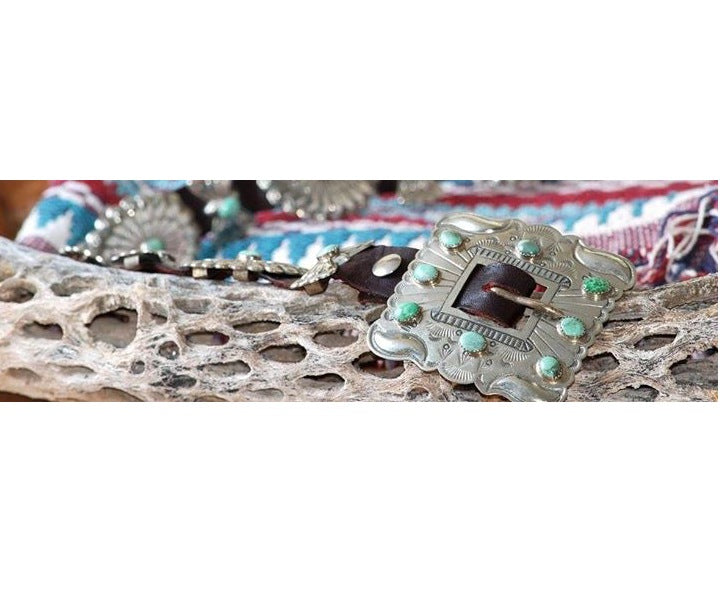
Here we continue our helpful glossary of terms commonly used in reference to Native American jewelry…
LAPIS LAZULI – also known as Lazurite, this deep blue (sometimes tending to indigo) semi-precious stone has been valued worldwide and is especially noted in ancient Egyptian archaeological finds. It is found in Afghanistan, Pakistan, Siberia, Chile, Canada, and the USA.
MALACHITE – this semi-precious green variegated stone is a mineral carbonate of copper. Opaque and with green and black bands, its use dates to ancient Egypt and it was believed to hold magical powers. High-quality malachite is rather rare and the stone is found from Zaire to Russia, Europe to Australia, and in Arizona and New Mexico. It’s a popular addition to the Native American jewelry of the Southwest and is notably seen in inlaid Zuni pieces where it complements turquoise.
MATT – or matte refers to a non-reflective finish on silver and other metals.
MOTHER OF PEARL – derived from the interior surface of the mollusk shell, it is used in Zuni inlay jewelry and has a milky-white, pink, gray-blue, or grayish-silver appearance.
NAJA – this Navajo word refers to the crescent-shaped pendant suspended from squash blossom necklaces. It is also sometimes suspended from horse bridles.
NAVAJO – the largest US Native American Reservation, the Navajo Nation occupies land in Arizona, New Mexico, and Utah. Also referred to as the Dine, these Native American people of the southwest are renowned for their weaving and silversmith work. Navajo jewelry tends to be distinctive for its embossing and the use of turquoise.
ONYX – a form of chalcedony quartz and usually black, this opaque, near-opaque, or translucent stone is popular in Zuni and Navajo jewelry. If the chalcedony is variegated, it is called agate.
OPAL – formed as silica from decomposing rocks that mixed with groundwater, most opal is between 50-65 million years old. It appears in an array of colors, from blue to green, white, pink, and black, with iridescent flashes of red, blue, yellow, and green.
OVERLAY – notable in Hopi jewelry designs, this silversmithing technique involves soldering two layers of silver together.
PENDANT – refers to a jewelry piece that is worn suspended from a necklace. They may also be worn as a pin or brooch in some cases.
QUARTZ – a crystalline mineral that is usually transparent when polished and available in an array of colors. Pure quartz is colorless.
SANDCAST – a technique whereby metal is cast in molds made of stone.
SANTO DOMINGO – a Native American Pueblo tribe renowned for their shell and turquoise heishi bead necklaces and traditional pottery making.
SHANK – refers to the part of a ring that encircles the finger.
SQUASH BLOSSOM – an traditional heirloom jewelry style of many native Americans (the Navajo in particular) and worn by women, young girls, medicine men, and chiefs, it features beads (usually silver) with “petals”.
STERLING SILVER – 92.5% silver combined with 7.5% copper for enhanced strength.
SPINY OYSTER – the orange sell of this marine creature has long been used in Naïve American jewelry, especially Zuni inlay work. The shell comes in shades from dark red-orange to yellowish and, like coral, is often set alongside Turquoise for a striking effect.
TUFA CASTING – metal is cast in molds made of porous rock created by volcanic ash.
TURQUOISE – a semi-precious stone made of phosphate of copper and aluminum. The Navajo are particularly renowned for their Native American Turquoise jewelry and the stone is also widely used by the Zuni in their distinctive inlay designs. Ranging from aqua-blue to green and even shades of yellow and white, turquoise is found in arid regions where copper is also abundant. One needs to be aware of whether turquoise is genuine/natural or chemically enhanced or stabilised.
ZUNI – Native American Pueblo peoples of western New Mexico. They are renowned for their silver and turquoise/jet/coral/ and other semi-precious inlay jewelry, beadwork, fetishes, pottery and basket weaving.
NOTE: We generally refer to most gemstones as semi-precious; precious gemstones in the lapidary industry include the likes of faceted or polished cabochon diamond, sapphire, emerald, and ruby. In Native American jewelry, however, the most valuable (“precious”) gemstones typically used are Turquoise, Onyx, Lapis, and Opal.
Check out our full range of Native American jewelry here – if you have any queries, just ask us a question via our CONTACT FORM and we’ll be delighted to help!
